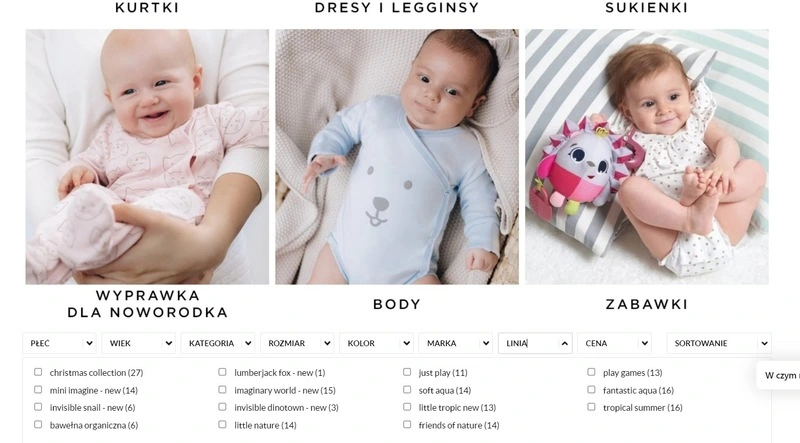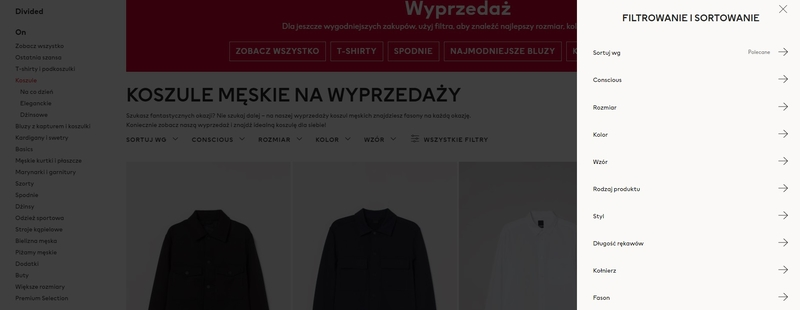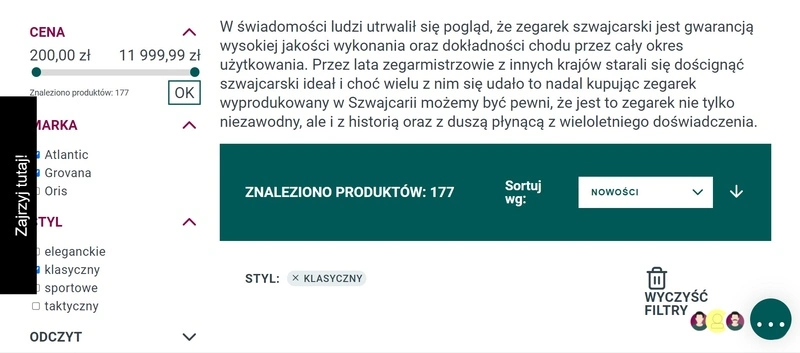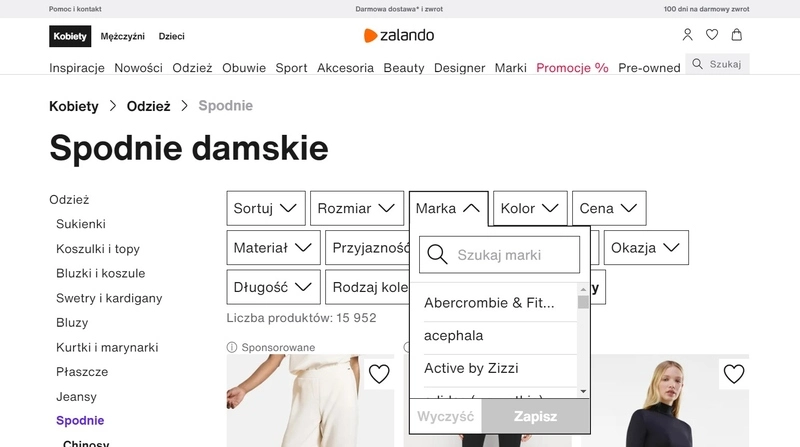Faceted search (also called faceted navigation or faceted browsing) in an online store is undoubtedly among the more important design issues for offering a positive, satisfying user and customer experience.
This shouldn't surprise us.
Faceted search in e-commerce has settled in for good and has become a crown functionality in most major stores.
Smaller online stores follow the example of large e-commerce platforms and want to offer functionalities that are considered standard. Faceted search is precisely that.
It's also perhaps the most efficient, convenient, and satisfying way to obtain search results that ever appeared in e-commerce.
What is faceted search? What is faceted navigation all about? How can we improve faceted search UX? What opportunities, problems, and challenges do online stores that use this solution face? And, of course, which design patterns are worth copying and using and which should definitely be avoided?
These questions won't go unanswered. We'll provide them in this article.
What is faceted search? A small terminological confusion
Let's start with a somewhat surprising question. Do you feel a little dizzy as you read articles on faceted search, and after a few texts, you no longer know what is what and what is different from each other?
A bit of terminological confusion has built up around this issue. Different authors use different terms, and they use them interchangeably. Various terms function as synonyms and the differences between them are sometimes blurred.

Well, it's time to brighten up the darkness a bit. Let's start with the term faceted. The noun "facet" means a side, an aspect of something.
Aspects are almost instantly, at least in e-commerce, associated with filters.
Are we also dealing with synonyms in this case of filtering and faceted navigation? No, definitely not. Although these terms refer to a similar subject and have similar designations, they are not the same.
While every aspect is a filter, not every filter is an aspect. The difference is not purely semantic. Aspects are about presenting characteristics and attributes. It's about defining and using more specific, narrow criteria to distinguish one product from another.
When it comes to search filters, the idea is to create more general categories that contain objects that are sometimes far apart in our maps and mental models. For example, "slippers" and "boots," although belonging to the category of shoes, are instead seen as distinctly separate categories.
If we specify that the slippers are men's slippers, size 44, made of leather, black, and available in a stationary store, then we specify and use the aspects of this product that are important to us.
Faceted search is about finding a product that can be visualized in a very specific way.
How to determine aspects?
In her article "Defining Helpful Filter Categories and Values for Better UX," Kate Moran suggests tailoring filters in e-commerce and their aspects to each product or service type. Why?
Users of digital products, including customers of online stores, have concrete expectations about a store's appearance and operation based on numerous experiences.

Preferences, expectations, experiences, perceptions, and ways of responding determine e-commerce customers' very specific approaches to searching.
Understanding mental models (which also consist of preferences in terms of filtering, product sorting, and searching in e-commerce) is the most effective way to meet customers' needs.
Although detailing store content is time-consuming and requires dedicated research (such as card sorting), it helps to reflect the structure of aspects in the way e-commerce customers think and search. The effort is definitely worth it.
Offering highly accurate faceted search affects user experience, comfort, the credibility of an online store, loyalty, and willingness to repeat purchases.
Here is a little reminder that a store where we cannot find a product quickly and seamlessly is a store that doesn't have the product, even if it is untrue and has hundreds of units of it.
That's why providing an intuitive user experience is essential.
What is faceted search used for, and how does it work?
Let's refer to Kathryn Whitenton's article "Filters vs. Facets: Definitions," published on the NN Group blog.
Both facets and filters are used to find information and products more efficiently. They are used to find the most relevant, accurate, matching, and exhaustive results for a user's query. In short, they can be utilized to refine search results.

So, how do they differ? As Kathryn Whitenton argues, faceted navigation extends and deepens the filtering capabilities with special filters. It helps to reach results that are much more precisely defined through various aspects of a given object.
Faceted search is much more flexible. It consists of multiple filters (search facets) that more comprehensively and multidimensionally describe the collection that a customer wants to find with their help.
However, according to Kathryn Whitenton, this solution also has some drawbacks or limitations. Faceted navigation requires the user to be more involved and focused.
Online store customers have to understand and manipulate many more options and data and handle much more information cognitively. This means that the cost of interacting with faceted search is much higher.
So here we have an example of a classic situation – "something for something."
While categories and subcategories of products or services allow us to conclusively answer whether something belongs to category X (e.g., men's pants) or category Y (e.g., women's pants), a faceted search results in an object that indicates the simultaneous presence of several aspects.
For example, women's pants, black, slim, denim, and size S, in the price range from 60 to 100 USD.
The general category indicates belonging, role, function, and aspects, making it possible to determine objects' attributes and thus express more individual preferences within general collections.
Faceted navigation allows us to reach our destination more efficiently. It's a faster, more convenient way to describe preferences than typing a classic keyword into a search engine, especially since faceted search makes it possible to select, for example, a dozen features. It's easier to sort through them and determine the relationships connecting them.
It would be extremely difficult, or even impossible, to indicate the relationships between individual nouns and adjectives with such a large number of words making up the search queries using only linguistic forms.
After all, the main goal of faceted search is to help users navigate through our e-commerce store.
What are the advantages of faceted search?
We've already mentioned them briefly, and now it's time to discuss, in more concrete terms, the advantages of faceted search, interface, and navigation.
Although the interaction cost is higher for faceted search, it's still the most efficient and effective way to reach the desired results in e-commerce.
Furthermore, faceted search is:
- Faster than navigating, for example, through category and subcategory structures.
- More efficient in terms of time and quality, as well as the relevance of search results.
- More illustrative — it allows us to discern the general and detailed content of the store quickly.
- Informative — for first-time buyers of a product from a given category, facets draw attention to its most important attributes.
- Much more optimal in terms of screen space utilization, which is especially important in M-Commerce.
- Recommended for managing large and very diverse collections.
- Much more lifelike, natural, and in line with the way an online shopper thinks and performs a site search.
- Much more flexible and goal-oriented.
- Much more accessible and handy (aspects allow us to recall or realize the existence of some features of products or services).
- More accurate — it reflects the search logic used by e-commerce/m-commerce customers much more accurately.
In particular, expensive products that require a greater purchase commitment and are chosen more rationally are easier to find, compare, learn about, and evaluate with faceted search.

For this reason, faceted navigation is sometimes called guided navigation because it allows us to guide a customer of an online store through more specific, detailed attributes to the product that best answers their multi-faceted query.
Moreover, getting lost in the structure of the catalog with such a handy guide is much more difficult.
It's also worth remembering, and there is evidence of this in the form of research (we recommend the article "The State of E-Commerce Search" on this topic), that faceted search has become a standard in e-commerce today and is a functionality widely expected by online store customers.
The specificity, adequacy, and relevance of search results also help to reduce the phenomenon of decision paralysis that we face when we receive very general results. It's much easier to choose from a dozen results than from a few hundred, and it's even easier with only a few options available.
Yet another effect and advantage of faceted search is that it offers greater control over the search process thanks to the thought-through interaction of e-commerce customers with the user interface.
The customer, the user of the store, can reduce the results but also configure their content. By manipulating aspects, they're able to receive results that emphasize features that are important to them. They can find an exact product withouth conducting multiple searches.
This is also essential for quick comparisons, which online shoppers make almost all the time.
Faceted search. Recommended design patterns
Faceted navigation can be found on category pages and search results pages. Both variants are undoubtedly worth considering.
Category pages indeed contain more homogeneous products belonging to one, more general category, but if there are more than a dozen or so, using faceted search, even if simplified, makes sense.
Search results are usually much more heterogeneous collections, in which we can find products belonging to different categories, sharing a single characteristic or several.

The use of facets is of even greater importance and role in this case. They make it possible to select a collection of products that will most accurately meet the needs of the searcher.
However, regardless of its place in the website structure, faceted search should be designed based on crucial use cases, search analysis, benchmarking, and usability testing. And the structure of aspects should resonate as closely as possible with the mental models of online store customers.
For this to happen, aspects should be created for each product category. Creating overly broad, universal aspects is ineffective. Characterized by low usability, customers perceive them as useless and, in some cases, as misleading.
We should also consider the number of offered facets. Too many facets can cause confusion and increase the cognitive load instead of reducing it. On the other hand, providing too few might be seen as pointless because customers won't be able to find what they're looking for.

The way faceted search is offered has seen many variations (horizontal and vertical positioning) and combinations of selection options (e.g., hyperlinks, checkboxes, and drop-down lists).
We should present facets based on the data they're supposed to filter. For example, if you filter something by brand, then checkboxes perfectly fit this type of facet.
How the variants and selection options are configured is almost always a matter determined by the following:
- Size, complexity, and heterogeneity of assortment
- Attributes of particular types, categories, and groups of products
- Channel in which the search is offered
- Expectations of the store's customers
- Type of data
- Requirements, constraints, and industry characteristics
The primary goal of faceted search, guided navigation, and faceted interface is:
- Speed, efficiency, and relevance of the search.
- Ability to configure and edit aspect filters.
- Obtaining even a single result — offering empty collections of search results is strongly discouraged.
- Consistency and handiness of the interface and intuitiveness of navigation.
In addition, when designing a faceted search, it's a good idea to:
- Display the number of products that will be available for selection when a particular filter is applied.
- Offer a clear distinction between the filters that have already been used.
- Provide the ability to edit filters and completely reset them.
The attributes of the products should be clear, understandable, and relevant to both customers who are familiar with the product category and those who are buying a particular type of product for the first time.
A given filter's meaning should be clear and seen as useful. The most popular, useful filters and aspects should be offered first.
Tips for designing faceted search:
- Discover and understand users' needs
- Create intuitive user interfaces
- Avoid information overload
- Make sure that the names of the facets are easily understandable
Faceted search provides many benefits for e-commerce stores. It improves the user and customer experience in a tangible and measurable way.
Faceted search in e-commerce. Summary
- Faceted search in e-commerce is a standard functionality.
- Faceted navigation is efficient, convenient, and liked. Allows users to find products efficiently.
- Faceted search is used to find the most relevant, accurate, matching, and exhaustive results.
- In e-commerce, certain aspects are synonymous with filters.
- Remember, every aspect is a filter; not every filter is an aspect.
- Aspects are used to present characteristics and attributes. They help determine preferences using more specific and narrow criteria.
- One key design principle is to tailor the filters, especially the aspects for each product type.
- Customers of online stores have concrete expectations about the look and operation of the store.
- Preferences, expectations, experiences, perceptions, and ways of responding determine e-commerce customers' very specific approaches to searching.
- Learning about mental models is the most effective way to design a useful faceted search.
- A precise faceted search affects user and search experience, comfort, the credibility of an online store, loyalty, and willingness to repeat purchases.
- Faceted navigation is an extension and deepening of the capabilities of classic filters.
- Faceted search allows us to get much more precisely defined results.
- Faceted search is much more flexible, but faceted navigation requires the user to be more involved and focused.
- The cost of interacting with this functionality is higher.
- Faceted navigation is a faster, more convenient way to express preferences than typing a classic keyword into a search engine.
- This is currently the most efficient and effective way to reach results in e-commerce.
- Faceted navigation is sometimes called guided navigation.
- Getting lost in the catalog structure is much more difficult with it.
- The accuracy of search results helps reduce the phenomenon of decision paralysis.
- The customer, the store user, can reduce the results and configure their content.
- Faceted navigation can be found on category pages and search results pages. Both variants are undoubtedly worth considering.
- Faceted search should be designed based on crucial use Cases, search analysis, benchmarking, and usability testing.
- The structure of aspects should resonate as closely as possible with the mental models of online store customers.
- The primary goals of faceted search, guided navigation, and faceted interface are speed, efficiency, search accuracy, and configurable, editable aspect filters.
- A given filter's meaning should be clear and seen as useful.
- The most popular, useful filters and aspects should be offered first.
Disclaimer
The sample prices presented in the article do not constitute a commercial offer within the meaning of the Polish Civil Code.





